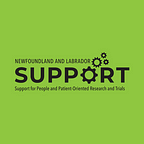A Trainee’s Reflections on Foundations in Patient-Oriented Research Training
By Rebecca Puddester
When I was introduced to patient-oriented research (POR), I knew instantly that I had found my approach to research. After all, hearing the experiences of patients affected by hereditary cancer was the signpost that led me to pursue research. Indeed, POR is not a ‘hard-sell’ for many nurse researchers; central to our nursing practice is our duty to ensure that patients and families are heard and respected as active partners in their healthcare. It seems natural that this sense of duty would overflow into our research. Thus, it was not surprising that I was among several other nurse researchers/research trainees who took part in the 2022 CIHR Foundations of POR training sessions, offered by NL SUPPORT.
While POR had persistent appeal to me long before the Foundations in POR training, there were key takeaways for me following my participation in the training sessions:
- It can, and often does, take more time to conduct POR studies in comparison to non-POR studies (but that isn’t a bad thing!). Coordinating schedules and prior commitments of patient partners, aligning expectations among team members, ensuring a ‘right fit’ among team members in a research project — all these considerations will likely elongate a study timeline. However, while in some cases a POR approach may not be the most expedient, in the end, the results of POR are invaluable. Too often in research, ideas and interventions are conceptualized without any input from those who stand to be affected by them. I have come to believe that this is a contributing factor as to why so many research findings are left on the shelf to collect dust. If our end goal of research is to make a sustainable impact on the communities we serve, co-building research with patients, families, and other people or groups who will be affected by the research increases the likelihood of achieving that impact, even if a POR approach adds a few extra steps in the research process.
- In a POR approach, creativity and diversity in knowledge development and translation (KT) are encouraged and celebrated. If I’m to be completely forthcoming, I’ve had moments since beginning doctoral studies of what I call ‘existential ambivalence’, where I have questioned if I possess what is required to fit into some of these deeply embedded structures that mark success in academia and research. What was particularly refreshing about the POR training was that it shone a spotlight on non-traditional ways to conduct and present research evidence for different audiences (knowledge users). The facilitators of the Foundations in POR training provided examples of non-traditional KT, such as a theatre production that presented research findings about how women with breast cancer make decisions about surgical treatment. Women with lived experience of breast cancer were actors in that stage performance! I agree that justification for policy and intervention are rightfully dependent on the highest quality research publications, usually the result of several large, well-designed quantitative studies. However, my participation in the sessions eased some of my existential ambivalence and helped me to see that there are multiple, creative, yet rigorous ways of answering research questions and equally creative ways to ensure that this research reaches relevant audiences to catalyze change.
- It is essential that science and society move forward together. While this statement may seem redundant, it bears repeating again through the example of how the training sessions were delivered by NL SUPPORT staff (Kathleen Mather and Julia Burt) and patient partner, Ms. Dorothy Senior. We were able to hear about Dorothy’s involvement in POR projects and how these projects are enacting change in real-time in the NL healthcare system. As trainees, we remarked that Kathleen, Julia and Dorothy complimented each other fabulously in the delivery of session content. It was a living example of an effective POR team. We benefitted from the different perspectives on the training content, and it showed how we are stronger together through patient engagement.
Consistent ‘bright spots’ in my first year of doctoral studies were my interactions with NL SUPPORT, including these training sessions. I would encourage anyone interested in health research to consider participating in the POR training sessions. I would also be remiss if I did not take this opportunity to acknowledge Mr. Mike Warren, a patient partner with NL SUPPORT with whom I have been privileged to collaborate. Even in the earliest pre-conceptualization phases of my research, Mike has provided important insight and contributed ideas from his experiences with previous research projects. His ideas have allowed me to reflect on my approaches and my assumptions, and to arrive at conclusions that I would not have arrived at independently. Moreover, he consistently provided me with words of encouragement. As we share a vision in what I hope to accomplish through my research, it was incredibly beneficial and motivating for me to be able to discuss my prospective research with someone who believed in its value. For this, I am grateful and look forward to continuing our imPORtant work!
Subscribe to our monthly newsletter at http://bit.ly/SupportLettersSubscribe.
